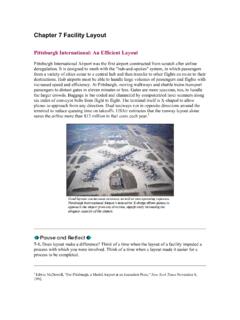Transcription of Roads: Geometric design and layout planning
1 Roads: Geometric design andlayout planningChapter 77 TABLE OF CONTENTSSCOPE .. 1 INTRODUCTION.. 1 Reference to planning .. 1 Classification of the road and street system.. 2 Measures of effectiveness (MOE) .. 3 Traffic calming .. 4 BASIC design PARAMETERS .. 4 The design vehicle.. 4 The design driver .. 5 The road surface .. 5 THE ELEMENTS OF design .. 6 design speed.. 6 Ceiling speed .. 6 design hour .. 6 SIGHT DISTANCE .. 8 Stopping sight distance (SSD) .. 8 Barrier sight distance (BSD) .. 8 Decision sight distance (DSD) .. 10 Passing sight distance (PSD) .. 10 Intersection sight distance (ISD) .. 10 HORIZONTAL ALIGNMENT .. 13 Tangents .. 14 Curvature and superelevation .. 14 Superelevation runoff.. 14 VERTICAL ALIGNMENT .. 15 Curvature .. 15 Gradients.. 17 Climbing lanes .. 18 CROSS-SECTION design .. 19iGUIDELINES FOR HUMAN SETTLEMENT planning AND DESIGNR oads: Geometric design and layout planningChapter 7iiGUIDELINES FOR HUMAN SETTLEMENT planning AND DESIGNC hapter 7 Roads: Geometric design and layout planningLanes.
2 19 Shoulders .. 21 Medians and outer separators .. 22 Verges .. 22 Sidewalks .. 22 Slopes .. 24 INTERSECTIONS .. 24 Introduction .. 24 Location of intersections.. 25 The types of intersection control ..26 The form of intersections .. 28 Intersection components .. 29 Mini-roundabouts .. 32 BIBLIOGRAPHY .. 35 LIST OF TABLEST able between classification systems ..3 Table of design vehicles (m) (after Wolhuter and Skutil 1990) ..4 Table turning radii ..5 Table force coefficients ..6 Table design and ceiling speed ..7 Table sight distance on level roads ..8 Table sight distance ..9 Table sight distance on level roads ..10 Table sight distance on level roads ..10 Table sight distance ..13 Table superelevation for various classes of road ..14 Table radii for horizontal curves (m) ..14 Table and minimum lengths of superelevation runoff ..15 Table values of K for vertical curves ..16 Table length of vertical curves.
3 17 Table gradients on major roads (%)..17 Table volume warrants for climbing lanes ..19 Table width of verge elements ..23 Table criteria for sidewalk width ..24 Table rates ..30 Table edge treatments for left turns ..30 Table traffic conditions ..32 Table roadway widths (m) ..33iiiGUIDELINES FOR HUMAN SETTLEMENT planning AND DESIGNR oads: Geometric design and layout planningChapter 7ivGUIDELINES FOR HUMAN SETTLEMENT planning AND DESIGNC hapter 7 Roads: Geometric design and layout planningLIST OF FIGURESF igure speed on grades ..5 Figure sight distance on gradients ..9 Figure horizontal radius for stopping sight distance ..9 Figure sight distance for turning manoeuvre ..11 Figure sight distance for crossing manoeuvre ..12 Figure sight distance for yield condition ..12 Figure of the cross-section ..20 Figure bus stop layouts ..23 Figure of skew ..27 Figure of island ..32 SCOPEIn this chapter the major objectives are to stress the importance of Geometric design , givingexpression to planning concepts; emphasise the revised approach to the roadhierarchy; suggest the importance of satisfying the needs ofall road users, both vehicular and non-vehicular;and provide guidelines for detailed Geometric designthat will result in a safe, efficient, affordable andconvenient road and street system.
4 INTRODUCTIONR eference to planning The ultimate objective in the creation of an urbanplace is that it should be such that people would wishto live, work and play there. This can only be achievedby the closest co-operation between the planner andthe Geometric designer, because the ultimate layout ofthe street system effectively defines the urban area interms of its functionality and, hence, its attractivenessto the inhabitants. These two disciplines must also interact closely withthe other disciplines involved in the provision ofservices to the inhabitants. As streets also form sets ofconduits along which essential services such as watersupply, sewerage and power are conducted, theyshould be so located that they do not unnecessarilyconstrain the provision of these chapter of the guidelines cannot, therefore, beread in isolation. Both the planner and the designer are required toadopt a more holistic approach to determination ofthe street network than has previously been the may find it useful to consider the total width ofthe cross-section as being hard open space, only partof which is dedicated to the movement function.
5 Thispart of the cross-section is roughly equivalent to theroad reserve as previously understood and is stillrequired to address a range of trip purposes, tripcomponents and modes of travel. With regard to modes of travel, the design of the streetnetwork was historically predicated almost exclusivelyon the passenger car. Many trip makers will, however,always be reliant on walking or public transport as theonly modes available to them. Furthermore, it is notpossible to endlessly upgrade the street network interms of a growingpopulation ofpassenger cars. Road design should, therefore, not only accom-modate public transport but actively seek toencourage its use. Adding embayed bus stops to aroute essentially designed for passenger cars does notconstitute support for the promotion of publictransport. Obviously, bus routes should be designed with the busas the design vehicle.
6 This selection of design vehicleimpacts, inter alia, on decisions concerning maximumgradients, lane widths and provision for bus stops. Adesignated bus route should have a horizontalalignment planned to enhance the attractiveness ofthe route to would-be passengers and also be highlyaccessible to pedestrians by ensuring that walkingdistances to the nearest bus stop are bus lanes should be provided in areas wherethe volume of bus or other high-occupancy vehicleswarrants their use. The dedicated bus lane implies thatthe street will essentially be a shared facility servingother modes of transport as well. The high volumes ofbus traffic that are typically achieved when a numberof bus routes converge on the CBD or some othertransport hub may suggest that dedicated bus routes,as opposed to bus lanes, become a practical option. The distinction drawn between Geometric planning andgeometric designis not always clear.
7 In this document, Geometric planning is described in chapter 5: PlanningGuidelines. A brief exposition of the differencebetween planning and design is offered below. Geometric planning planning addresses the broad concepts in terms ofwhich the functions of the various links in thestreet network are defined. These concepts addressthe sum of human activity, whether economic(which can be formal or informal), recreational orsocial - the latter including educational, health careand worship activities. In this context, it is pointedout that movement is a derivedactivity or demand. Previously, both planning and design tended tofocus on areas being dedicated to single land-use,thus forcing a need for movement between theliving area and any other. Current planningphilosophies favour the abandonment of single usein favour of mixed use. Mixed use suggests thatpeople can both live and work in one area.
8 Notonly will this have the practical effect of reducingthe demand for movement over long distances but,where movement is still necessary, it will supportchange of the mode of movement because, overshort distances, walking and cycling are practicaloptions. This will further reduce the areal extentrequired to be dedicated to movement. Conceptualplanning leads to the definition of corridorsintended to support some or other activity, one ofwhich is movement. 1 GUIDELINES FOR HUMAN SETTLEMENT planning AND DESIGNR oads: Geometric design and layout planningChapter 72 GUIDELINES FOR HUMAN SETTLEMENT planning AND DESIGNC hapter 7 Roads: Geometric design and layout planningCorridors, in association with their intendedfunctions, will ultimately define the horizontalalignment of the streets located in them. A needfor high traffic speeds will suggest high values ofhorizontal radius, whereas reductions in radiuscould be applied to force speeds down to matchactivities involving a mix of vehicular and non-vehicular traffic.
9 Reduction of the lengths oftangents between curves or intersections couldserve the same purpose. The dominant function of the corridor defines thevertical alignment in terms of maximum andminimum acceptable gradients, vertical curvatureand length of grade. For example, streets with apredominantly pedestrian function should ideally beflat, whereas - if movement includes provision for abus route - modest gradients are allowable. Routesintended principally for the movement of vehiclesother than buses may be steeper although, wherevery high volumes are anticipated, the adverseeffect of steep gradients must be borne in mind. Function is defined in terms of two primecomponents, namely the nature and the extent ofdemand. As such, it is the major informant of thedesign of the cross-section. The demand may be forhigh-speed, high-volume traffic flows, in whichcase the cross-section would comprise more thanone moving lane in each direction, possibly with amedian between the opposing flows and shouldersas opposed to sidewalks.
10 On the other hand, if thedemand is for predominantly pedestrian/commercial activity, very wide sidewalks ( widerthan would be required merely to accommodate avolume of moving pedestrians) would be necessaryto allow for sidewalk cafes, roadside vending andbrowsing or window shopping. While vehicleswould not necessarily be excluded, their presencewould not be encouraged and speeds would beforced down by having few and narrow lanes andvery short tangent lengths. Geometric designDesign is principally concerned with converting tophysical dimensions the constraints introduced byplanning concepts. Ongoing reference to thechapter on planning is necessary to ensure that theroad as ultimately designed matches the intentionsregarding its function. It is important to realise thatthe function of the road reserve is broader thanmerely the accommodation of moving traffic whichmay be either vehicular or pedestrian.









